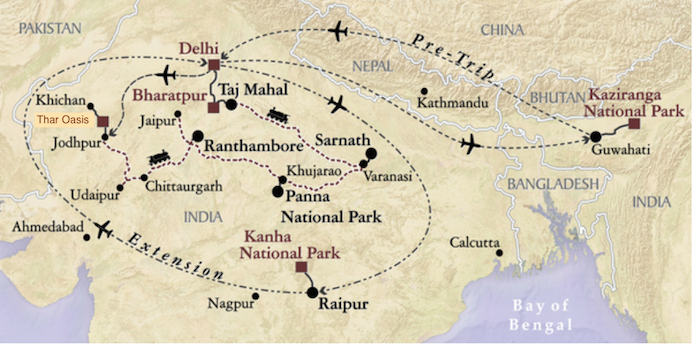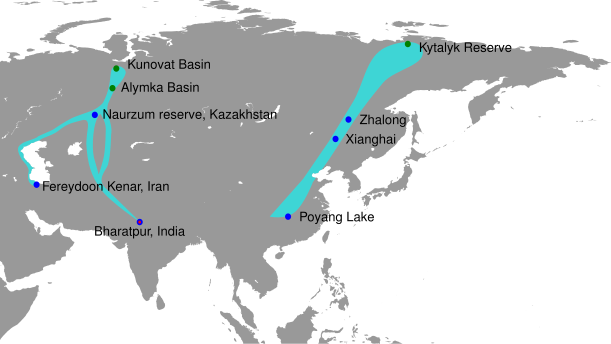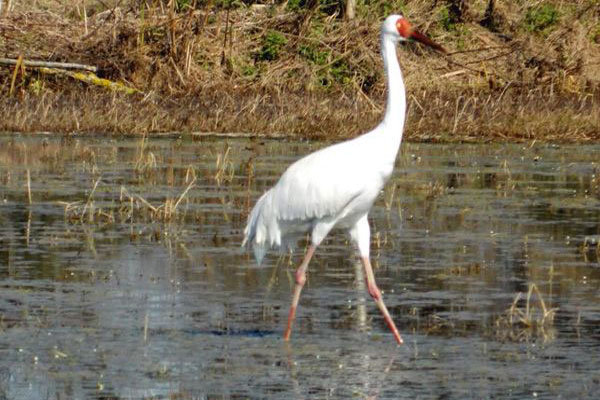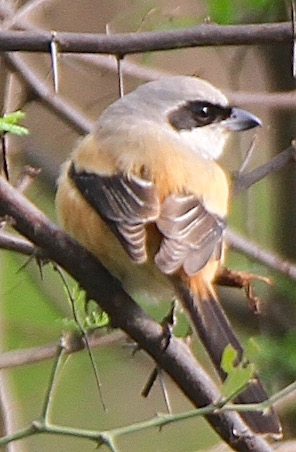
Today we explored Keoladeo National Park at Bharatpur in Rajasthan
(Image courtesy of VENT)
(Click on images to enlarge)

 Sarus Cranes at Keoladeo National Park (Image courtesy of UNESCO) |
The reason one comes to Bharatpur is its
World Heritage Site, Keoladeo
National Park (which is often called simply “Bharatpur”), an
internationally important wetlands area, originally created to provide duck
hunting for a maharaja. Though surrounded by agriculture and development and a
dense human population, it provides 11 square miles of protected wetlands and
forests that are critical to many migratory bird species.
It has taken great effort to preserve the land and, most importantly, its water and will continue to do so. The park now provides 5,000 jobs (including in hotels and such) for the 50,000 residents of the town. A few years ago, the wetlands were drying up because a dam in another state had cut the flow of water the park received from the river. As conditions worsened, UNESCO threatened to remove the World Heritage status of the park. People in Bharatpur staged a hunger strike to demand water for their wetlands, but farmers near the dam, who needed the water, threatened suicide if any water were diverted to the park. The matter became highly politicized and the park essentially dried up. The problem has now been resolved more or less, but it will take years for normal conditions to be restored. (And one feels safe in predicting that the battles over water will be worse in the future, both here and around the world.) Sarus Cranes, one of the key species, returned to Bharatpur in small numbers in 2014 after an absence of five years. |
|
The big treat for the morning came when we found a pair of Sarus Cranes. We
heard them before we saw them, but then our path gradually converged with theirs
until they were only about 20 yards away from us. They were so beautiful! And
it was so wonderful to watch them interacting with one another.
This may have been the same pair that are shown in this video of a pair of cranes dancing and doing unison calls, which was made at Bharatpur in January. (Those are Nilgai behind them in the video.) We were so close that I could appreciate the beautiful gradations from red to black in the coloring on their heads and necks. What magnificent creatures! Amy, who has been passionate about crane conservation since she was 13, got some very good photos. |
 Sarus Crane, Keoladeo National Park (Image courtesy of Amy Sheldon) |
| After seeing the cranes, we were pedaled about three kilometers back to the entrance of the park and our bus. That gave me time to think about the crane we didn’t see but should have, the Siberian Crane. If we had been here in 1968, we might have seen the 86 Siberian Cranes that the great Peter Jackson saw then. Even as recently as the winter of 2001-2, we could have seen a pair of them. In Mughal days, they were all over India in the winter, but as human populations grew, Bharatpur became their last refuge. Today Siberian Cranes are no longer found in India at all. |
 Siberian Cranes at Keoladeo National Park, 1968 (Photograph by Peter Jackson) |
|
There used to be three wintering populations of Siberian Cranes. Those that
breed in eastern Siberia spend the winter in China, and there are at least 2,000
of them still alive today. Those that bred in western Siberia used to split
into two populations over the winter, some going to Iran and some going to
India. Sadly, their flight paths took them across lands where they were hunted.
It is particularly unfortunate that one of their best “refueling”
stops was in the Amu Darya wetlands, east of Kabul. The International Crane
Foundation says of the “central population”, the one wintering in
India, “There is a high probability this population has been recently
extirpated.”
Even if Keoladeo’s water problems were completely solved (and the Siberian Cranes require more and deeper water than other species of crane), it is unlikely that a reintroduction of the Siberian Crane into India would succeed unless the birds could be trained to take a safer migration route. |
 Siberian Crane migration routes (Image courtesy of Wikimedia Commons) |
 Omid in Iran (Image courtesy of Mehr News Service) |
As for the western population, which used to breed along the south coast of the Caspian Sea, it, too, has failed in recent years. Omid, the last remaining Siberian Crane of the western population, made it to Iran for the winter at the beginning of November, 2014. He was alone, his last two companions having been shot. (This was his seventh trip from Siberia to Iran.) |
| We were soon back in the hotel, where we rushed to the dining room and had another Indian buffet lunch, quite a reasonable one, though the dishes have begun to blur together in my mind. We then had an hour and a half in our room before we had to go out again. I got Lee set up to use the Mac with the limited Internet access available. He was obviously tired and aching, so had decided to stay in for the afternoon. |
| Things went better after that as we wandered around collecting woodlands birds, including a Red Collared-Dove, a Dusky Eagle-Owl adult and fledgling, an Ashy Drongo, a Long-tailed Shrike, and a Brahminy Starling (among others): |
 Long-tailed Shrike, Keoladeo National Park (Image courtesy of Amy Sheldon) |
 Brahminy Starling, Keoladeo National Park (Image courtesy of Amy Sheldon) |
 Indian Flapshell Turtle, Keoladeo |
We were about to leave when the priest asked if we would like to watch him feed
the soft-shelled turtles in the adjacent lake, which he does every day. (Dion
says these are Indian Flapshell Turtles.) The priest walked down some stairs to
the water carrying a bucket of a sort of porridge and began calling to the
turtles, who showed up immediately. I was amazed that turtles can learn to come
to being called, but these clearly had. They came in many sizes, including
enormous.
I took a bunch of photos to show Lee, who surely would have enjoyed being there. Dion had never before seen the turtle feeding, though he has been to this park many times. If you would like to see and hear it just as we did, this video, though taken another day, is exactly like what we saw and heard. |
 Hindu priest feeding the turtles |
|
It was dusk by the time we had made the trip by rickshaw and bus and were
finally back at the hotel. I found that Lee the news-junkie had managed to
download the Times during the day despite the low bandwidth here and
had had a good nap. I went with him to the dining room to do the checklist but
then left when the others started dinner, so I could have some time to work on
my journal. As Amy and Zach, sadly, must leave us tomorrow to start their
journey home, she kindly brought me her three remaining granola bars, two of
which I ate for my dinner as soon as I got back to our room. (Replenishing our
supplies assumes increasing importance the further into the trip we get.) Lee
stayed to have dinner with the others, but we were able to get to bed reasonably
early.
My birds for the day included a dozen lifers (I didn’t make it to 100 species for the day, but the group as a whole certainly did): |
| Lesser Whistling Duck | Greylag Goose | Bar-headed Goose | Comb Duck | Ruddy Shelduck |
| Gadwall | Indian Spot-billed Duck | Northern Shoveler | Northern Pintail | Garganey |
| Green-winged Teal | Indian Peafowl | Little Grebe | Black-necked Stork | Painted Stork |
| Indian Cormorant | Great Cormorant | Little Cormorant | Oriental Darter | Black Bittern |
| Grey Heron | Purple Heron | Eastern Great Egret | Intermediate Egret | Little Egret |
| Eastern Cattle Egret | Indian Pond Heron | Glossy Ibis | Black-headed Ibis | Eurasian Spoonbill |
| Black-shouldered Kite | Egyptian Vulture | Oriental Honey-Buzzard | Greater Spotted Eagle | Eastern Imperial Eagle |
| Eurasian Marsh-Harrier | Shikra | Black Kite | White-breasted Waterhen | Purple Swamphen |
| Common Moorhen | Eurasian Coot | Sarus Crane | Indian Thick-knee | Black-winged Stilt |
| Red-wattled Lapwing | White-tailed Lapwing | Bronze-winged Jacana | Common Redshank | Rock Pigeon |
| Red Collared-Dove | Laughing Dove | Greater Coucal | Indian Scops Owl | Dusky Eagle-Owl |
| Spotted Owlet | White-throated Kingfisher | Pied Kingfisher | Green Bee-eater | Indian Roller |
| Eurasian Hoopoe | Indian Grey Hornbill | Brown-headed Barbet | Coppersmith Barbet | Black-rumped Flameback |
| Rose-ringed Parakeet | Small Minivet | Long-tailed Shrike | Black Drongo | Ashy Drongo |
| Rufous Treepie | House Crow | Grey-throated Martin | Grey-headed Canary-Flycatcher | Red-vented Bulbul |
| White-eared Bulbul | Dusky Warbler | Hume’s Leaf Warbler | Greenish Warbler | Ashy Prinia |
| Lesser Whitethroat | Jungle Babbler | Indian Robin | Oriental Magpie-Robin | Bluethroat |
| Black Redstart | Common Myna | Asian Pied Starling | Brahminy Starling | Purple Sunbird |
| Indian Silverbill |

